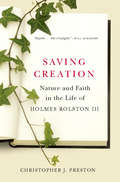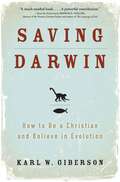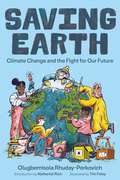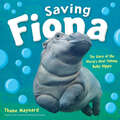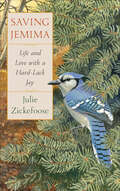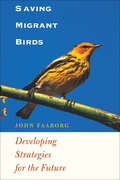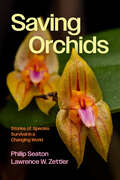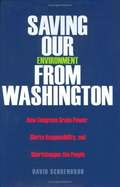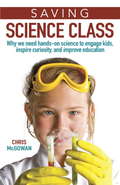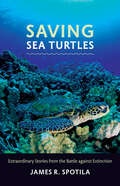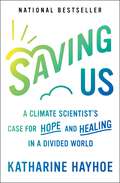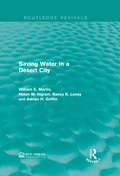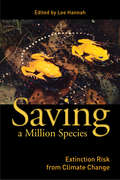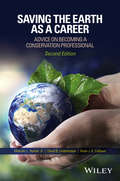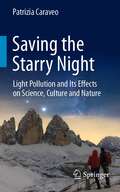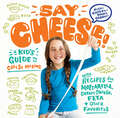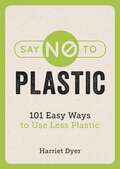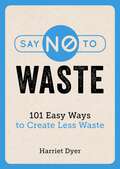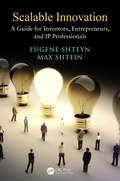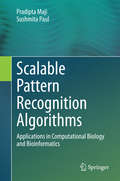- Table View
- List View
Saving Creation
by Christopher J. PrestonHolmes Rolston III has long been recognized as the "father of environmental ethics." Internationally renowned for the synthesis he has found in evolutionary biology and Christianity, Rolston has followed an immensely interesting life course. In this compelling biography, Rolston's story is traced from childhood to the present, detailing the process by which he has come to hone his profound philosophies. Culled from countless interviews with Rolston himself, along with his family and colleagues, this biography is both an engaging life story and a compendium of Rolston's thoughts on the value of nature, resource management, aesthetics, international development, and the relationship of culture to nature, wilderness, and natural theology.
Saving Creation
by Christopher J. PrestonHolmes Rolston III has long been recognized as the "father of environmental ethics." Internationally renowned for the synthesis he has found in evolutionary biology and Christianity, Rolston has followed an immensely interesting life course. In this compelling biography, Rolston's story is traced from childhood to the present, detailing the process by which he has come to hone his profound philosophies. Culled from countless interviews with Rolston himself, along with his family and colleagues, this biography is both an engaging life story and a compendium of Rolston's thoughts on the value of nature, resource management, aesthetics, international development, and the relationship of culture to nature, wilderness, and natural theology.
Saving Darwin: How to Be a Christian and Believe in Evolution
by Karl W. GibersonEvolution Is Not the Bible's EnemySaving Darwin explores the history of the controversy that swirls around evolution science, from Darwin to current challenges, and shows why—and how—it is possible to believe in God and evolution at the same time.
Saving Earth: Climate Change and the Fight for Our Future
by Olugbemisola Rhuday-PerkovichA timely and inspiring nonfiction guide for middle grade readers about the history of our fight against climate change, and how young people today are rising to action. Inspired by Nathaniel Rich’s Losing Earth: A Recent History, the acclaimed book that grew out of an August 2018 issue of the New York Times Magazine solely dedicated to it, Saving Earth tells the human story of the climate change conversation from the recent past into the present day. It wrestles with the long shadow of our failures, what might be ahead for today’s generation, and crucial questions of how we understand the world we live in—and how we can work together to change the outlook for the better. Written by acclaimed author Olugbemisola Rhuday-Perkovich and enlivened with illustrations from Tim Foley, and filled with the voices of climate activists from the past and present, this book is both a call to action and a riveting dramatic history.A Junior Library Guild Selection
Saving Fiona: The Story of the World's Most Famous Baby Hippo
by Thane MaynardThe amazing, true story of Fiona, a baby hippo born prematurely at the Cincinnati Zoo, the team of scientists and caregivers who nursed her to health, and the vast community in Cincinnati and beyond who rallied around her. Includes full-color behind-the-scenes photographs throughout. On a cold January day in 2017, nearly two months before due date, Nile hippopotamus Bibi gave her keepers at the Cincinnati Zoo & Botanical Garden a big (little) surprise—a tiny newborn hippo, no bigger than a football. The first premature hippo born and raised in captivity, baby Fiona was an underdog from the start: she couldn't nurse, she couldn't stay hydrated, and she wasn't thriving. But the staff at the zoo knew they could save her. It would take creative thinking and teamwork. They would have to study the makeup of hippo milk for the first time ever and reach out to medical colleagues, including a team at the local Children's Hospital with superior vein-finding skills, to ensure that Fiona would begin to gain weight and become healthy. When Fiona began to thrive, her star began to rise, and soon she became an internet sensation, her picture and videos garnering thousands and thousands of likes and fans on Instagram and Facebook. Now a Fiona appearance at the Zoo mimics a Beatles concert. What made this little, now big, hippo such a big hit with people all over the world? And what's in store for her and her family in the future?
Saving Graces: Sojourns of a Backyard Biologist
by Roger B. Swain"What Lewis Thomas is to microbes, Roger Swain is to woodchucks." - People
Saving Jemima: Life and Love with a Hard-Luck Jay
by Julie Zickefoose“All blue jays have a penchant for stealing, but Jemima will steal your heart. Three cheers for this spunky baby bird.” —Sy Montgomery, New York Times–bestselling authorWhen Jemima, a young orphaned blue jay, is brought to wildlife rehabilitator Julie Zickefoose, she is a virtually tailless, palm-sized bundle of gray-blue fluff. But she is starved and very sick. Julie’s constant care brings her around, and as Jemima is raised for eventual release, she takes over the house and the rest of the author’s summer. Shortly after release, Jemima turns up with a deadly disease. But medicating a free-flying wild bird is a challenge. When the PBS show Nature expresses interest in filming Jemima, Julie must train her to behave on camera, as the bird gets ever wilder. Jemima bonds with a wild jay, stretching her ties with the family. Throughout, Julie grapples with the fallout of Jemima’s illness, studies molt and migration, and does her best to keep Jemima strong and wild. She falls hard for this engaging, feisty and funny bird, a creative muse and source of strength through the author’s own heartbreaking changes.Emotional and honest, Saving Jemima is a universal story of the communion between a wild creature and the human chosen to raise it.“Mixing cute blue-jay stories with scientific facts, the author teaches readers lots of ornithology, and, by adding tales of the simultaneous turmoil her family was undergoing, she shows how nature and animals can heal heartbreak. Zickefoose has produced another hard-to-put-down winner!” —Booklist (starred review) “A heartwarming account for all interested in natural history, especially birds, animal behavior, and wildlife rehabilitation.” —Library Journal
Saving Migrant Birds: Developing Strategies for the Future (Corrie Herring Hooks Series)
by John Faaborg&“Rigorous and well defended . . . Faaborg makes many fresh and, in some cases, provocative points regarding management guidelines for migrant birds.&” —Kenneth Able, Great Plains Research In the 1980s, numerous scientific surveys documented both declining bird populations, especially among Neotropical songbirds that winter in the tropics, and the loss of tropical rain forest habitat. Drawing the seemingly obvious conclusion, scientists and environmental activists linked songbird declines to loss of tropical habitats and alerted the world to an impending ecological catastrophe. Their warnings led to the establishment of the Neotropical Migratory Bird Conservation Program, also known as Partners in Flight, the self-proclaimed largest conservation effort in history. Looking back over more than a decade of efforts to save migrant birds, John Faaborg offers the first serious evaluation of the state of songbird populations today, the effectiveness of conservation programs such as Partners in Flight, and the reliability and completeness of scientific research on migrant birds. Taking neither an alarmist nor a complacent approach, he shows that many factors besides habitat loss affect bird populations and that Neotropical migrants as a group are not declining dramatically, though some species adapt to habitat alteration more successfully than others. Faaborg&’s state-of-the-art survey thus clarifies the kinds of information we will need and the conservation efforts we should undertake to ensure the long-term survival of Neotropical migrant birds. &“Presents a carefully and closely reasoned argument about the magnitude of the conservation problems facing migrant birds, how we can reduce these problems, and how current conservation efforts have enormous value even if there is no immediate crisis.&” —Scott K. Robinson, Professor and Head, Department of Animal Biology, University of Illinois
Saving Orchids: Stories of Species Survival in a Changing World
by Philip Seaton Lawrence W. ZettlerA gorgeously illustrated ode to the beauty and significance of orchids—and to those fighting to save these unique plants across the globe. Until recently, a myriad of lifeforms enriched our lives. In some places, listening to a nighttime chorus of frogs in the neighborhood marsh was an archetypal touchstone of childhood. Children would search for tadpoles, just steps away from native Lady’s Tresses orchids. Year by year, the chorus became quieter. Today, only a few frogs and orchids remain. Is this the world we want our children to inherit? Do we want orchids to slip through our fingers and, eventually, to vanish? For biologists Philip Seaton and Lawrence W. Zettler, and the intrepid orchid defenders they introduce in this book, the answer is no. Seaton and Zettler have traveled the world over the past three decades, studying orchids—flagship species for plant conservation. Stunningly illustrated, this book is a culmination of stories about the people—young and old alike—dedicated to protecting these remarkable plants from extinction. In the 19th century, collectors removed, shipped, and sold vast numbers of orchids from the wild. Today, scientists strive to reverse this harm—to protect and rebuild remnants of orchids’ original habitats against human disruption, including climate change. Seaton and Zettler reveal these plants’ bizarre pollination partners, risky liaisons with fungi, and adaptation to human domestication to show that learning orchids’ scientific secrets—and finding human helpers—is key to these plants’ survival.
Saving Our Environment from Washington: How Congress Grabs Power, Shirks Responsibility, and Shortchanges the People
by David SchoenbrodCongress empowered the Environmental Protection Agency on the theory that only a national agency that is insulated from accountability to voters could produce the scientifically grounded pollution rules needed to save a careless public from its own filth. In this provocative book, David Schoenbrod explains how his experience as an environmental advocate brought him to this startling realization: letting EPA dictate to the nation is a mistake. Through a series of gripping and illuminating anecdotes from his own career, the author reveals the EPA to be an agency that, under Democrats and Republicans alike, delays good rules, imposes bad ones, and is so big, muscle-bound, and remote that it does unnecessary damage to our society. EPA stays in power, he says, because it enables elected legislators to evade responsibility by hiding behind appointed bureaucrats. The best environmental rules-those that have done the most good-have come when Congress had to take responsibility or from states and localities rather than the EPA. With the passion of an authentic environmentalist, Schoenbrod makes a sensible plea for "bottom-up" environmental protection now. The responsibility for pollution control belongs not in agencies but in legislatures, and usually not at the federal level but rather closer to home.
Saving Right Whales
by Barbara A. DonovanA mother right whale floats lazily on the surface of the water. Her calf swims close by and then rests by its mother with its tail across the mother's back.
Saving Science Class: Why We Need Hands-on Science to Engage Kids, Inspire Curiosity, and Improve Education
by Christopher McgowanMuch of what our students are learning about science in school bears little resemblance to real science. That is the main theme of this critique of science education by a veteran scientist and former school teacher. The author charges that today's teaching mandate has been taken over by educational specialists, people with little or no understanding of science. They clutter curricula with extraneous material, like engineering and technology, and focus so much attention theorizing over hypotheses and models and categorizing everything, that no time remains for doing science. There is little to entice youngsters to the science classroom today. McGowan emphasizes that the problem is not the teachers but the materials they are obliged to teach. He is especially critical of the widely influential "Next Generation Science Standards" (NGSS). This is based upon "A Framework for K-12 Science Education," which has been inordinately influenced by educational specialists. This is evident from the esoteric language, the almost exclusive citation of educational publications, and by glaring errors in science. The author urges a rethinking of science education to bring the focus back to conducting real hands-on science in the classroom. This approach was pioneered by the Nuffield Science Teaching Project in the UK, where working scientists acted as resource personnel for teachers designing curricula. Given the catastrophic problems facing planet Earth, scientific literacy has never been more important.From the Hardcover edition.
Saving Sea Turtles: Extraordinary Stories from the Battle against Extinction
by James R. SpotilaIn April 2007, eleven leatherback turtles captured the imagination of the public worldwide as they "raced" from Costa Rica toward the Galápagos Islands. Known as the Great Turtle Race, this event tracked these critically endangered sea turtles, drawing attention to their fragile status and generating data on the turtles vital to efforts to study and protect them.But the Great Turtle Race is just one of many tools marine conservationists use to inform people about the status, biology, and lives of the seven sea turtle species. Due to human actions, once-plentiful sea turtle population levels plummeted throughout much of the twentieth century, stabilizing somewhat only after Archie Carr and Jacques Cousteau popularized their plight. With Saving Sea Turtles, award-winning author James R. Spotila picks up where Carr and Cousteau left off, going inside the modern-day conservation movement to tell the tales of today’s sea turtle conservationists. He provides a complete overview of sea turtle biology and life cycles, discusses the human and natural world threats they face, and examines the new methods and technologies humans are using to save them. Throughout, Spotila dots the narrative with stories of real-life heroes who risk life and limb to understand, track, and conserve sea turtles across the globe.Spotila has been at the forefront of sea turtle research and conservation for decades. His inspirational story of dedicated individuals, creative endeavors, and adventure reveals what is being done and what else we must do in order to ensure that these fascinating animals continue swimming in the oceans.
Saving Us: A Climate Scientist's Case for Hope and Healing in a Divided World
by Katharine HayhoeUnited Nations Champion of the Earth, climate scientist, and evangelical Christian Katharine Hayhoe changes the debate on how we can save our future in this nationally bestselling &“optimistic view on why collective action is still possible—and how it can be realized&” (The New York Times).Called &“one of the nation&’s most effective communicators on climate change&” by The New York Times, Katharine Hayhoe knows how to navigate all sides of the conversation on our changing planet. A Canadian climate scientist living in Texas, she negotiates distrust of data, indifference to imminent threats, and resistance to proposed solutions with ease. Over the past fifteen years Hayhoe has found that the most important thing we can do to address climate change is talk about it—and she wants to teach you how. In Saving Us, Hayhoe argues that when it comes to changing hearts and minds, facts are only one part of the equation. We need to find shared values in order to connect our unique identities to collective action. This is not another doomsday narrative about a planet on fire. It is a multilayered look at science, faith, and human psychology, from an icon in her field—recently named chief scientist at The Nature Conservancy. Drawing on interdisciplinary research and personal stories, Hayhoe shows that small conversations can have astonishing results. Saving Us leaves us with the tools to open a dialogue with your loved ones about how we all can play a role in pushing forward for change.
Saving Water in a Desert City (Routledge Revivals)
by William E. Martin Helen M. Ingram Nancy K. Laney Adrian H. GriffinThis book was stimulated by and sets out to analyse a political battle over water pricing by a municipal system. Originally published in 1984, this title provides improved methods for demand function estimation where block rates are involved, suggests procedures for rational pricing of municipal water, and explains how politics can dominate when real decisions are made. Due to the additional virtue of this title being easy to read, it is ideal for students interested in environmental studies, economics, and policy making, as well as for those involved with municipal services and resource management in general.
Saving a Million Species: Extinction Risk from Climate Change
by Lee Hannah Thomas LovejoyThe research paper "Extinction Risk from Climate Change" published in the journal Nature in January 2004 created front-page headlines around the world. The notion that climate change could drive more than a million species to extinction captured both the popular imagination and the attention of policy-makers, and provoked an unprecedented round of scientific critique. Saving a Million Species reconsiders the central question of that paper: How many species may perish as a result of climate change and associated threats? Leaders from a range of disciplines synthesize the literature, refine the original estimates, and elaborate the conservation and policy implications. The book: examines the initial extinction risk estimates of the original paper, subsequent critiques, and the media and policy impact of this unique studypresents evidence of extinctions from climate change from different time frames in the pastexplores extinctions documented in the contemporary recordsets forth new risk estimates for future climate changeconsiders the conservation and policy implications of the estimates. Saving a Million Species offers a clear explanation of the science behind the headline-grabbing estimates for conservationists, researchers, teachers, students, and policy-makers. It is a critical resource for helping those working to conserve biodiversity take on the rapidly advancing and evolving global stressor of climate change-the most important issue in conservation biology today, and the one for which we are least prepared.
Saving the Earth as a Career
by Malcolm L. Hunter Jr. David B. Lindenmayer Aram J. CalhounWritten in an informal and engaging style, Saving the Earth as a Career is an ideal resource for students and professionals pursuing a career in conservation. The book explores the major skills needed to become an effective conservation professional by offering useful advice on a range of topics. Chapters include: Is this the right career for you? Designing a program of study Designing and executing a project Attending conferences and making presentations Writing papers Finding a job Making a difference Saving the Earth as a Career 2e is a friendly, accessible guide with a global perspective for anyone interested in becoming a conservation or environmental professional, and teachers will find this an invaluable resource for university students at all levels.
Saving the Starry Night: Light Pollution and Its Effects on Science, Culture and Nature
by Patrizia CaraveoThis book takes a close look at our relationship with the sky, the stars, light and darkness. In particular, it examines how light pollution has interfered with the culture of astronomy and our ability to appreciate this essential facet of our natural world. The sky has always held significance for humanity, in both cultural and scientific terms. And yet we persistently pollute it with (sometimes unnecessary) light in our obsessive desire to chase away the darkness. This effectively switches off the stars, hampering our ability to enjoy one of the most inspiring sights nature has to offer to humankind. In addition, too much light is hazardous to both our health and that of the fauna and flora of this planet. This book also features a comprehensive look at the current controversy regarding efforts to expand internet access through the launch into low Earth orbits of thousands of new satellites, which will pollute the night with moving lights while filling to saturation the capability of the circumterrestrial space. This conflict does not mean that the interests of astronomy and those of space technology have to be at odds, and potential compromises are explored between the satellite initiative and the desire to maintain a dark, radio silent sky.
Say Cheese!: A Kid's Guide to Cheese Making with Recipes for Mozzarella, Cream Cheese, Feta & Other Favorites
by Sarah Carroll Ricki CarrollBest-selling author Ricki Carroll — known around the world as “the Cheese Queen” — and her daughter, Sarah Carroll, bring easy cheese making right into your kitchen with this fun guide for kids and families. Step-by-step photos take kids ages 8–12 through the cheese making process, then teach them how to make 12 classic favorites, including mozzarella, feta, ricotta, and cream cheese. A hearty helping of kitchen chemistry and math along with bits of international cheese making history add to the education. A bonus log sheet lets young cheese makers keep notes just like the pros, while punch-out labels and colorful flags will embellish homemade cheeses and global cheese platters.
Say No to Plastic: 101 Easy Ways to Use Less Plastic
by Harriet DyerWe’ve reached an environmental crisis point with plastic, and it’s time to take action. But is it possible to make positive changes without radically changing your lifestyle? Absolutely! This practical book suggests eco-friendly alternatives to plastic, including budget options, high-street substitutes and DIY ideas to help you drastically reduce your plastic consumption. With 101 simple ways to use less plastic, you’ll find it easy to take the first step and make a difference.
Say No to Waste: 101 Easy Ways to Create Less Waste
by Harriet DyerThe world is overflowing with waste. It’s time to take action. You can make positive changes without radically altering your lifestyle. This practical book suggests ways to reduce waste, including how to cut unnecessary packaging, patch up or recycle old household items and drastically limit food waste. With 101 simple ways to create less waste, you’ll find it easy to take the first step and make a difference.
Scaffolding In Tissue Engineering
by Peter X. Ma Jennifer ElisseeffThe growing interest in scaffolding design and increasing research programs dedicated to regenerative medicine corroborate the need for Scaffolding in Tissue Engineering. While certain books and journal articles address various aspects in the field, this is the first current, comprehensive text focusing on scaffolding for tissue engineering.
Scalable Innovation: A Guide for Inventors, Entrepreneurs, and IP Professionals
by Eugene Shteyn Max ShteinInnovation is a primary source of economic growth, and yet only one idea out of 3,000 becomes a successful product or service. Scalable Innovation: A Guide for Inventors, Entrepreneurs, and IP Professionals introduces a model for the innovation process, helping innovators to understand the nature and timing of opportunities and risks on the path to
Scalable Pattern Recognition Algorithms
by Pradipta Maji Sushmita PaulThis book addresses the need for a unified framework describing how soft computing and machine learning techniques can be judiciously formulated and used in building efficient pattern recognition models. The text reviews both established and cutting-edge research, providing a careful balance of theory, algorithms, and applications, with a particular emphasis given to applications in computational biology and bioinformatics. Features: integrates different soft computing and machine learning methodologies with pattern recognition tasks; discusses in detail the integration of different techniques for handling uncertainties in decision-making and efficiently mining large biological datasets; presents a particular emphasis on real-life applications, such as microarray expression datasets and magnetic resonance images; includes numerous examples and experimental results to support the theoretical concepts described; concludes each chapter with directions for future research and a comprehensive bibliography.
Scalar Boson Decays to Tau Leptons: in the Standard Model and Beyond (Springer Theses)
by Cécile CaillolThis thesis presents a study of the scalar sector in the standard model (SM), as well as various searches for an extended scalar sector in theories beyond the SM (BSM). The first part of the thesis details the search for an SM Higgs boson decaying to taus, and produced by gluon fusion, vector boson fusion, or associated production with a vector boson, leading to evidence for decays of the Higgs boson to taus. In turn, the second part highlights several searches for an extended scalar sector, with scalar boson decays to taus. In all of the analyses presented, at least one scalar boson decays to a pair of taus. The results draw on data collected by the Compact Muon Solenoid (CMS) detector during proton–proton collisions with a center-of-mass energy of 7 or 8 TeV.
